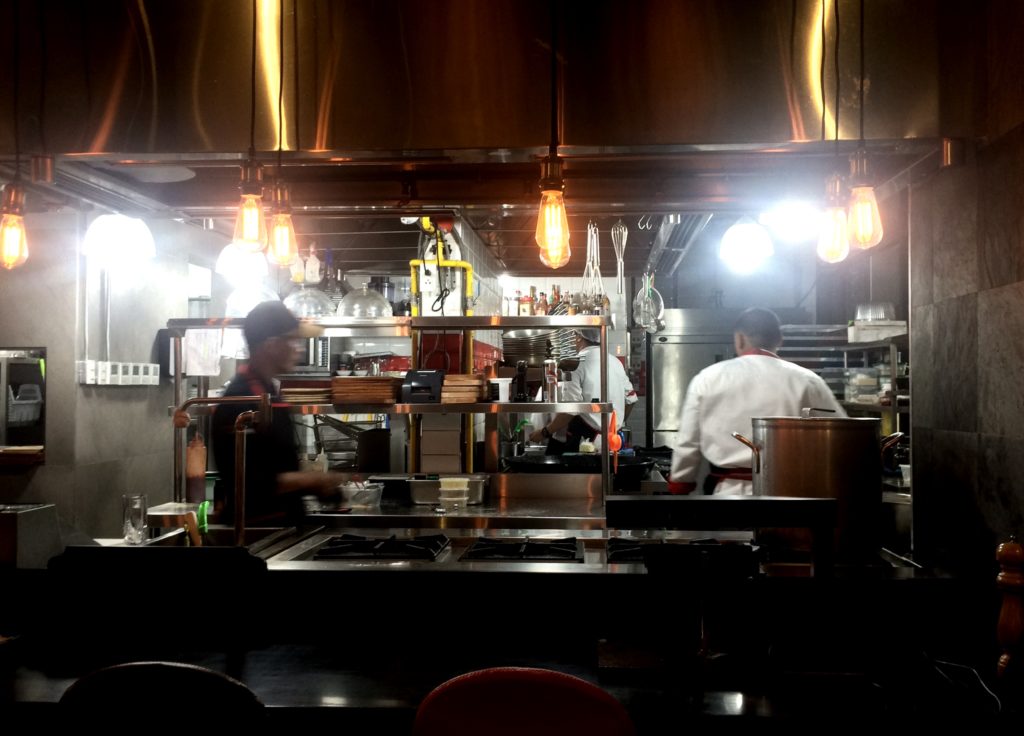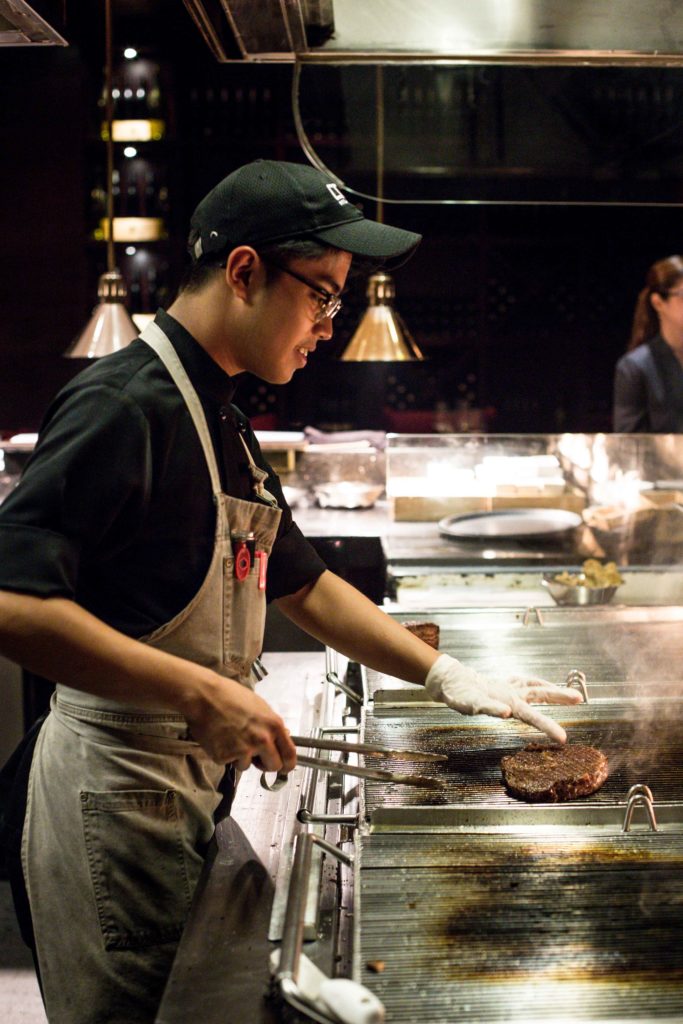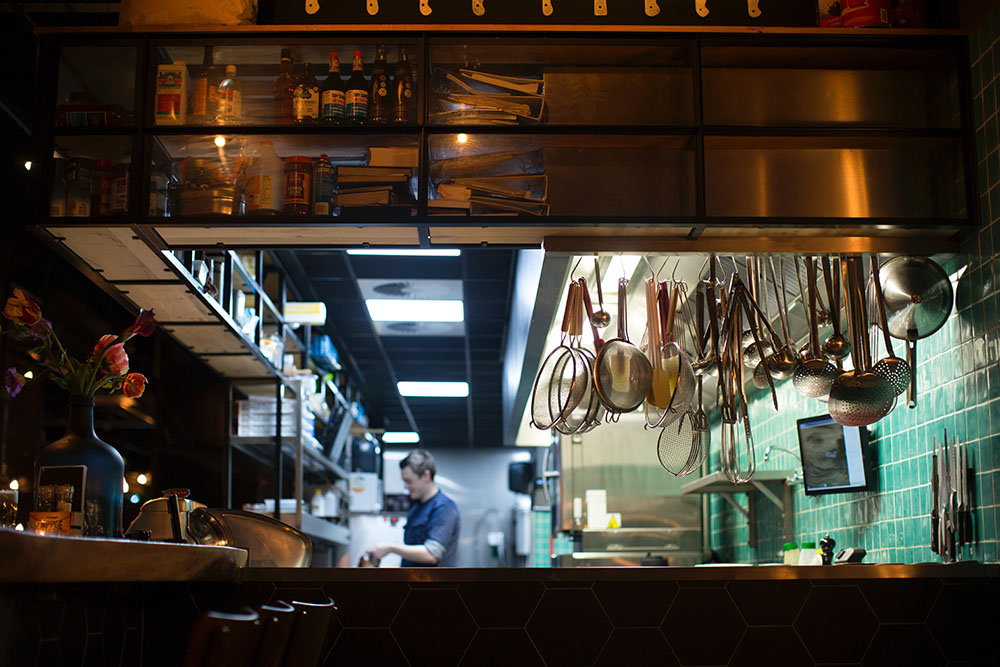Restaurants have to go on a limb to attract and keep customers these days. With the influx of new dining spots, establishments must go beyond specials and find ways to stay relevant in the food scene.
Open kitchens provide a permanent and live attraction at any restaurant. They give diners a sense of anticipation by showcasing a hypnotizing preview of the food that’s about to be served. Not to mention, a well-designed kitchen with copper pans and high-tech equipment set against exposed wooden bricks always leaves a good impression.
While open kitchens are meant to entertain, they do more than that. With this setup, restaurants are able to offer an implied transparency to customers. This lets them know that they’re invited to look because there is nothing to hide.
A firm believer of this concept is Marriott International. Marriott’s Cru Steakhouse in Manila is known for its US prime rib Eee, which is prepared before guests in a modern open kitchen. “Having transparency of how we prepare the food guarantees that everything on the guests’ plates was carefully and creatively prepared and with no extenders added,” says cluster director for marketing communications Michelle Garcia.
Another restaurant that built its design around an open kitchen is The Red Piano in Bonifacio Global City (Editor’s note: The Red Piano has permanently closed). Diners on the first floor have access to the 60-seat restaurant’s fully equipped, modern open kitchen, where they can watch classic and comfort food such as beef bourguignon, osso buco, carbonara, and Angus steak being prepared from start to finish.
Research conducted by Harvard Business Review also shows that open kitchens influence both customers and cooks. While it was noted that the food technically did not change in taste, it had encouraged cooks to do better since they could see who was eating the food and how their food was perceived.
When restaurant owner and chef Carlo Llave began conceptualizing his restaurant, he was immediately drawn to the open kitchen design for its interactive and straightforward appeal.
“I’ve always loved the concept of open kitchens because to me, it’s honest,” he says. “If I don’t hide anything from you, it means I’m telling you, ‘Listen, you can go to the heart of this operation, and see the ingredients I use, see how the food is prepared, and you will know the passion that goes into it.’ I don’t want to hide anything. It also keeps me honest.”
Research conducted by Harvard Business Review also shows that open kitchens influence both customers and cooks. While it was noted that the food technically did not change in taste, it had encouraged cooks to do better since they could see who was eating the food and how their food was perceived.
“Customer satisfaction with the food shot up 10 percent when the cooks could see the customers, even though the customers couldn’t see the cooks. In the opposite situation, there was no improvement in satisfaction from the baseline condition in which neither group could see the other,” said Ryan W. Buell, an assistant professor at Harvard Business School.
Service and customer satisfaction were higher when the kitchen staff and customers could see each other.
“…When customers and cooks both could see one another, satisfaction went up 17.3 percent, and service was 13.2 percent faster. Transparency between customers and providers seems to really improve service,” said Buell.
That said, open kitchens do have their drawbacks. Diners seated closest to the kitchen can get agitated by clanging pans and loud exchanges among kitchen staff. Smoke from the grill and other strong smells can also ruin the experience. Disorganized and messy workstations tell a lot about the sanitation processes of a restaurant, and turn off customers who see them. Any visible mistakes made by the staff affect the restaurant’s reputation and harm the business.

Considering an open kitchen for a restaurant should not be done for mere aesthetic purposes. “It’s about having the right reasons why you want to do it in the first place. You don’t do it because it’s trendy. It’s going to be like an aquarium. People are going to look at you and what you’re doing,” says Llave.
Here are the things to consider before deciding to go with an open kitchen.
The concept
The concept and menu are essential factors in deciding whether an open kitchen will complement the overall restaurant experience. For Cru Steakhouse, the open design made sense because it put the spotlight on its main offering: the steak.
“Grilling or as it is done in an ‘open space’—that complements our menu. Also, we highlighted [the steaks] by displaying [them] through a glass chiller visible to everyone. It’s our attempt at redefining fine dining—keeping it cozy but not casual, elegant but not boring, entertaining but not distracting.”
The space
Open kitchens require adequate space for equipment and staff who will be moving extensively around the area. Smaller spaces could work, but only if they are meticulously planned to ensure that every area is used efficiently.
“Cru was strategically built around having direct access to a bigger back kitchen and a separate pastry room. From there, getting the right equipment and the placement of each should be given attention,” says Garcia.
The Occupational Safety and Health Administration recommends a kitchen thermostat of 68 to 76 degrees Fahrenheit. Settings outside this range supposedly lead to more mistakes and entail the refrigerator compressors to work harder, which means a higher electricity bill.
Depending on the areas and workstations, good kitchen design should provide smooth workflow and prevent any accidents. Space should be considered and used well, and only the most necessary tools and equipment must be kept. They also have to follow standard kitchen requirements on temperature management, safety, and sanitation.
Grease and smoke released into the air during cooking may be unpleasant and unsafe to diners. For this reason, ventilation hoods are required, as recommended by the local health department. The Occupational Safety and Health Administration also recommends a kitchen thermostat of 68 to 76 degrees Fahrenheit. Settings outside this range supposedly lead to more mistakes and entail the refrigerator compressors to work harder, which means a higher electricity bill. In the Philippines, the ideal temperature in work areas is 26.67 degrees Celsius based on the 1995 Department of Health food establishments code of sanitation.
Proper storage of condiments, ingredients, and cooking tools is another important factor as well as disposal, as the sight of a cluttered workstation will likely distract diners or give them a bad impression.
“Stations that produce unpleasant or loud noises like the dishwashing area are placed at the back. A balance of fresh air and exhaust system are implemented. Several exhaust systems are installed to handle the smell or smoke, and these are maintained thrice a week,” says Garcia.

The upkeep
Building an open kitchen is a major feat, but so is its maintenance. Regular inspections, which entail spending, must be done to ensure that equipment is functioning properly and to keep the kitchen in good condition.
“The technical side of it, that also adds up [to the expense]. You need to know what you’re doing because you need to contain smoke, so the exhaust, the ventilation plays a very big part in it as well as the fire suppressor system. ‘Yung mga technical side kailangan ma-address mo,” says Llave.
Cru Steakhouse follows life safety design standards according to Marriott International’s property standards. The staff is trained on safe and proper handling of equipment, while an engineering team conducts inspections of fire alarms, sprinklers smoke controls, and power systems. A weekly inspection of grease traps is also implemented to prevent trash buildup. Good conditioning of floors, walls, ceilings, drainage, and grates are secured; a kitchen hood suppression system, meant to prevent kitchen fires, is regularly checked.
Building a regular back-of-the-house kitchen would have been less expensive, but because he was so adamant on building an open kitchen from the start, he had to spend twice as much. “If you want to have an open kitchen, make sure you’re prepared for the expense that it takes,” says Llave.
The cost
Open kitchens have to meet the technical requirements of a kitchen, carrying professional equipment that serve both as furniture and interior design for the restaurant.
“For an open kitchen to work, the kitchen equipment has to be professional. They need to look presentable because in themselves, they are furniture, so you need to invest,” says Llave.
“If you want to have an open kitchen, make sure you’re prepared for the expense that it takes,” says The Red Piano’s Carlo Llave.
Being exposed
Extensive staff training is also an essential part of open kitchens. The kitchen staff are no longer in the back of the house and must be comfortable being watched while preparing and cooking food.
“You have to have chefs who are presentable and have a flair for showmanship,” says Llave. “You can’t have chefs who are grumpy, so it’s an investment in the way that they appear, the clothes that they wear, how they conduct themselves in the kitchen. All of these have to be part of that. At the end of the day, it’s a performance. You’d be under a microscope.”
Originally published in F&B Report Vol. 15 No. 4





